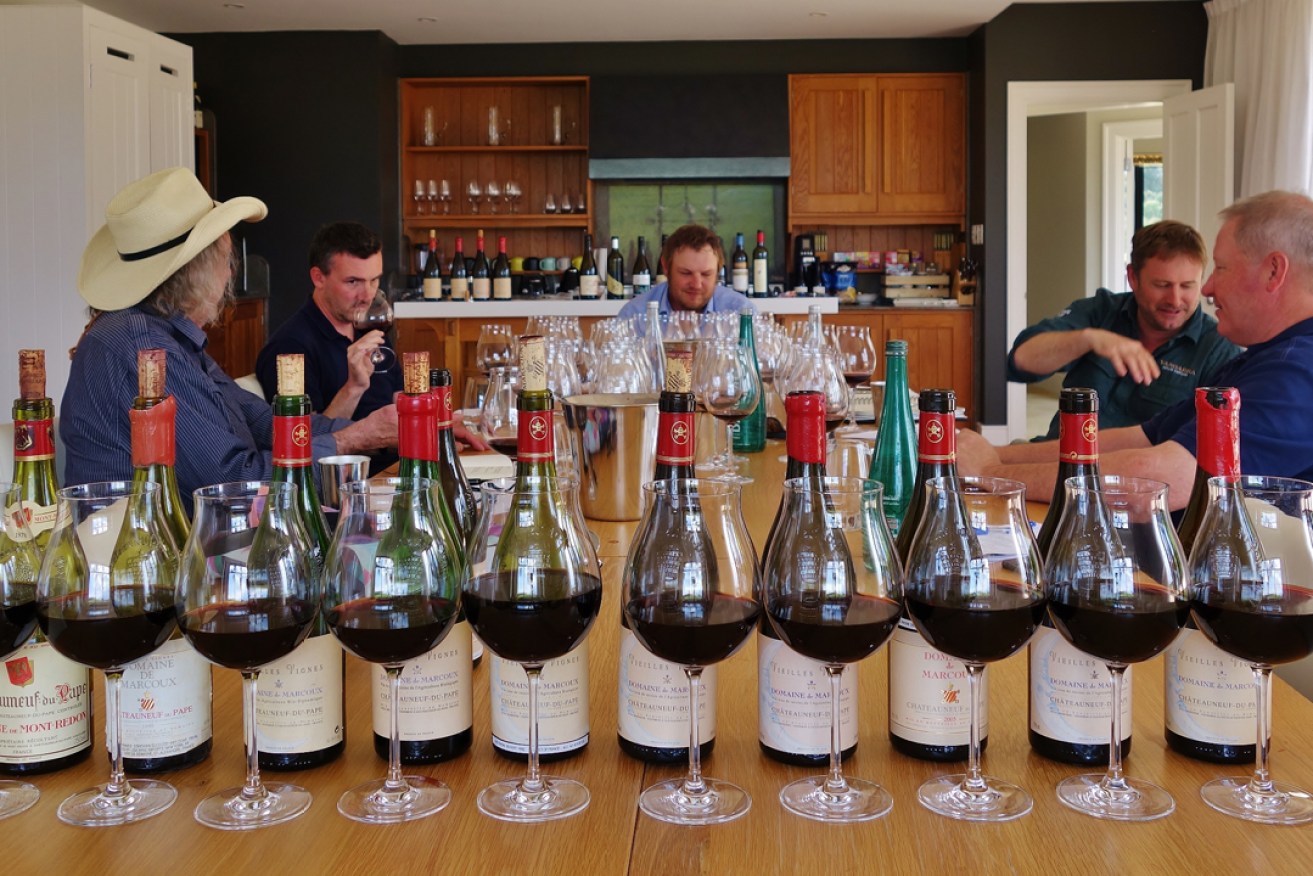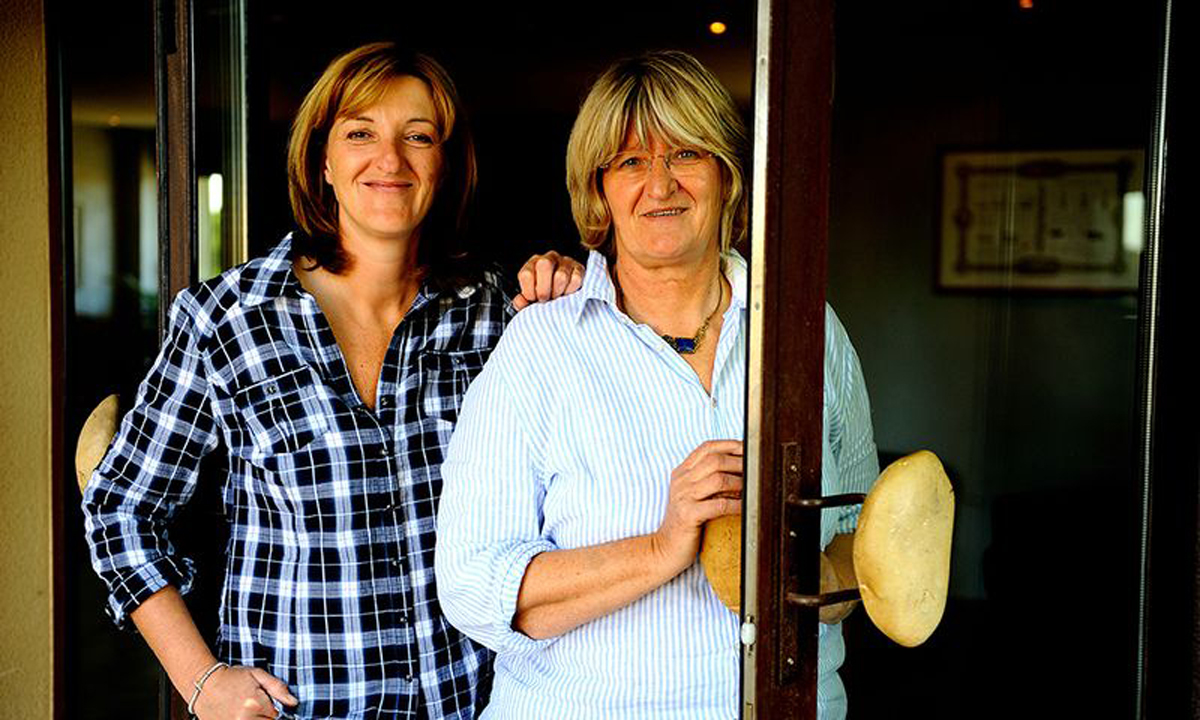An intimate trip: from one southern wine region to another
Having attended a very special tasting of Grenache, Philip White looks at how some rare vintages from a French family estate compare with wines from McLaren Vale and the Barossa.


Philip White, Pierre-Henri Morel, Joel Mattschoss, Peter Fraser and Michael Twelftree tasting Domaine de Marcoux.
It was one of those special tastings where one gets a chance to gaze over somebody’s fence. Perhaps the best example of Experiential Tourism. Have a quiet look into several decades of one family’s distinctive contribution to Grenache.
Barossa Two Hands man Michael Twelftree raided his own cellar and tabled a string of great vintages from the famed Armenier sisters, Sophie and Catherine, of France’s Châteauneuf-du-Pape.
Watching the way the Armeniers changed the direction of the old family estate is a real intimate, dead honest treat. After brother Philippe moved to the Napa and winemaker Sophie and business manager Catherine secured complete control of the company in 1996, you can see the brand finding its cult through consistence and sensitivity in vineyard and winery.
This tour of the highlights of their scarce grail, their Domaine Marcoux Vieilles Vignes, from 1990 to 2015, was like opening somebody else’s mail: it is that private. They make only about 300 cases a year of Vieilles Vignes, from three of the best of their priceless suite of little vineyards.
The sisters farm incredible 50-100+ years bush vine Grenache biodynamically a few kilometres from the Rhône. Their family, originally called Armani – no, not the Italian lot – were well-established in this south-of-France district in the register of 1344. They were probably there before any popes came fleeing from Italy.
The calcerious geology supported that little village of lime-burners so well it was called Châteauneuf Calcernier dit de Pape until 1893.
When I consider the limestone and calcrete, and the red and paler clays of McLaren Vale, I feel certain this Austral district could go very damn close to replicating the riverine alluviums of Châteauneuf.
Then the Kurrajong Formation of the Willunga Faultline and its escarpment often reminds me of bits of the Rhône delta, before it was washed to riverine roundness. It’s been a long time since a stream with the force of the Rhône came out of the Mount Lofty Ranges.
Instead, the Vales has the recent wind-blown æolian sand of Blewett Springs and Kangarilla atop much of its clay. Yum-o. And I’m not being an antipodean smartarse when I say the range of modern winemaking technologies well established in the best of McLaren Vale leaves most of Châteauneuf for dead.
There, a vast amount of the vintage is fermented and matured in open concrete vats and big old skanky oak the like of which most of the Vales left behind in the 1970s and ’80s. To be fair, the great makers of those days, like d’Arry, Jim Ingoldby, Reynella and Seaview, were quite capable of using old kit like that to make Grenache very much akin to the top of today’s Mediterranean France. And Spain.
Michael Twelftree brought his wines south from the Barossa with his Two Hands general manager, Pierre-Henri Morel, who worked for M. Chapoutier on the Rhône for 13 years before starting at Two Hands as sales and marketing director in 2014.
Joel Mattschoss, Wilton Hill Vineyard proprietor with probably Australia’s highest Grenache at 525 metres up on Mengler’s Hill in the Barossa Tops, came too.
Yangarra Estate boss Peter Fraser made us welcome in the White House on Hickinbotham Clarendon Vineyard. He brought Yangarra High Sands Grenache 2010 and ’15; we also tasted a few of the recent popular prize-winners from the Barossa and McLaren Vale.
The Marcoux wines were such open-hearted, honest reflections of Grenache from a particular spot with such a grand old culture that, as I say, tasting them seemed to involve the presumption of an intimate trust. They showed how very special Grenache is often unique for the disarming human-ness of its flesh. Which is probably why we like it. From pink bubby flesh to great powdered Rubensian folds, it can all seem deliciously human at its best.

Armenier sisters Sophie and Catherine, of France’s Châteauneuf-du-Pape.
Even my tasting references to pork belly or charcuterie meats, Nivea or tack dressing, cream and cherry gel all offer fairly thin drapes over the simple honest humanness of Grenache made with so much love that itself can degrade to simple obsession at the cost of due respect.
Which is not what happened here: We could see Sophie locking her winemaking in through 2000 and ’03, gathering pace in ’04 and ’05, then really changing gears with the tight clean precision of ’07. Then the ’12 was even more so, racy and fresh with the thrill of speed and risk.
To which I must have made a motoring rather than anthroposophical reference. Our colleague M. Morel made a remark about the profile of your average new age Châteauneufer in suggesting that while there are plenty of Lamborghinis crammed in the little burgh’s laneways, he’d never seen one in a vineyard.
“But it’s the biggest car show in Europe some weekends,” he said.
Somewhere in there lies the thing about Grenache. You can make it low and fast or cushy and luxurious; carbon fibre and titanium or plush old leather and rivets but in both extremes the sins are like totally carnal and indulgent.
Much more so, I suggest, than Pinot, which is more acidic and tannic. McLaren Vale Grenache is low in acid and tannin, but also has a low pH, which lessens the need for their preservative role. At the risk of contradicting myself and committing heresy, I continue however to dare McLaren Vale makers to nevertheless pick some of it earlier and learn to make it in accordance with that extra elegance at the risk of shedding some pounds in the flesh division.
I daren’t go so far with Barossa Grenache, however. I don’t understand the harsher, drier tannins there, arising I suspect from the region’s lower background humidity. The moistening, softening influence of Gulf St Vincent is the key to McLaren Vale.
Moisture, see? Geologies repeat everywhere.
So, what’s best? Locally, we need now to remember what we lost, and nearly lost forever in our national desertion of Grenache when the cool climate Cabernazis and Chardonneighs took over.
McLaren Vale, in particular, was making more wines along the lines of these gorgeous Domaine de Marcoux delights in the ’70s than it does now.
At the same time, wines like Kay Brothers’ two recent trophy-winners, including the Bushing King crown, show some have never stopped doing it with long-distance love and stoic determination.
The wine coming from Yangarra and Twelftree/Two Hands is another thing again. They’re gently edging some reinforcing science into this very old, mystifying intrigue.
It is this sort of modern intelligence which drew Pierre-Henri Morel to Australia.
drinkster.blogspot.com




